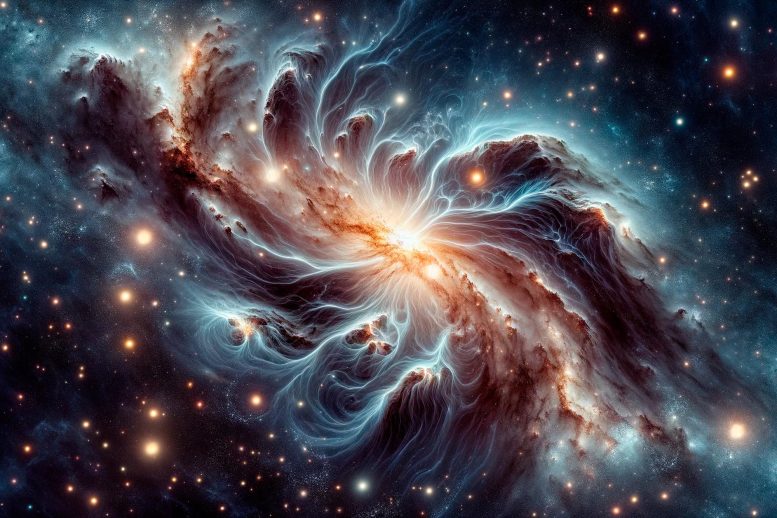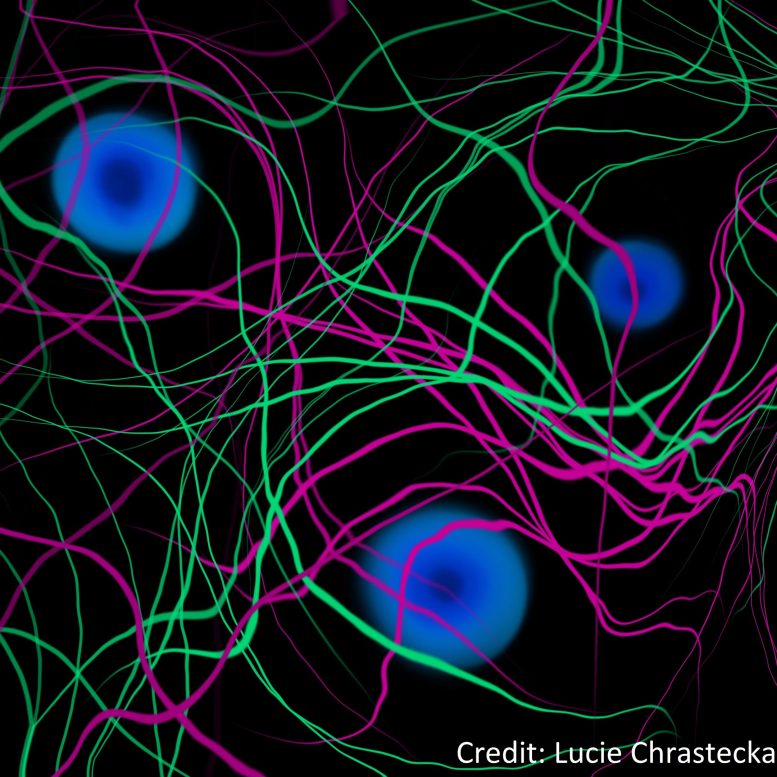
Researchers at SISSA propose that dark matter mini-halos in the universe could reveal the existence of primordial magnetic fields, offering new insights into the early universe and the nature of cosmic magnetic fields. Credit: SciTechDaily.com
We don’t know how magnetic fields formed. Now new theoretical research tells how the invisible part of our Universe could help us discover it, suggesting a primordial genesis, even within a second of the Big Bang.
The mini-halos of dark matter scattered throughout the Cosmos could function as highly sensitive probes of primordial magnetic fields. This is what emerges from a theoretical study conducted by SISSA and published in the journal Physical Review Letters.
Present on immense scales, magnetic fields are found everywhere in the Universe. However, their origins are still subjects of debate among scholars. An intriguing possibility is that magnetic fields originated near the birth of the universe itself, that is they are primordial magnetic fields.
In the study, researchers showed that if magnetic fields are indeed primordial then it could cause an increase in dark matter density perturbations on small scales. The ultimate effect of this process would be the formation of mini-halos of dark matter, which, if detected would hint towards a primordial nature of magnetic fields.
Thus, in an apparent paradox, the invisible part of our Universe could be useful in resolving the nature of a component of the visible one.

In the study, researchers showed that if magnetic fields are indeed primordial then it could cause an increase in dark matter density perturbations on small scales. The ultimate effect of this process would be the formation of mini-halos of dark matter, which, if detected would hint towards a primordial nature of magnetic fields. Credit: Lucie Chrastecka
Shedding Light on the Formation of Magnetic Fields
“Magnetic fields are ubiquitous in the Cosmos,” explains Pranjal Ralegankar of SISSA, the author of the research. “A possible theory regarding their formation suggests that those observed so far could be produced in the early stages of our Universe. However, this proposition lacks explanation in the standard model of physics.
To shed light on this aspect and find a way to detect “primordial” magnetic fields, with this work we propose a method that we could define as ‘indirect.’ Our approach is based on a question: What is the influence of magnetic fields on dark matter?” It is known that there is no direct interaction. Still, as Ralegankar explains, “there is an indirect one that occurs through gravity.”
Right From the Primordial Universe
Primordial magnetic fields can enhance density perturbations of electrons and protons in the primordial Universe. When these become too large, they influence the magnetic fields themselves. The consequence is the suppression of fluctuations on a small scale.
Ralegankar explains: “In the study, we show something unexpected. The growth in baryon density gravitationally induces the growth of dark matter perturbations without the possibility of subsequent cancellation. This would result in their collapse on small scales, producing mini-halos of dark matter.”
The consequence, continues the author, is that although fluctuations in the density of baryonic matter are canceled, they would leave traces through the mini-halos, all solely through gravitational interactions.
“These theoretical findings,” concludes Pranjal Ralegankar, “also suggest that the abundance of mini-halos is determined not by the present presence of primordial magnetic fields but rather by their strength in the primordial Universe. Thus, a detection of dark matter mini-halos would reinforce the hypothesis that magnetic fields formed very early, even within 1 second after the Big Bang.”
Reference: “Dark Matter Minihalos from Primordial Magnetic Fields” by Pranjal Ralegankar, 8 December 2023, Physical Review Letters.
DOI: 10.1103/PhysRevLett.131.231002









They have said that this is theoretical and in that admission could it be the opposite to a decrease in the dark matter density.
Who are “they” and why would a theoretical model be an “admission” and have physical effects? That one sentence is packed with oddity and seeming irrelevance.
Dark matter phase transition is the largest ionizer in the universe. When LDM state changes to GDM it releases heat into the fabric of spacetime. Electrons which vibrate in and out of spacetime absorb this heat thus ionizing material. Streams of Liquid Dark Matter when it reaches a Zero G equivalent vaporizes creating magnetic field lines.
Another odd and irrelevant couple of sentences. Dark matter has no observed phase transition, and observations tell us it is likeliest a gas – Cold Dark Matter.
Physicists are starting to think early galaxies are cigar-shaped. Most likely explanation is that gravitational lensing distortions are distorting those early galaxies.
As noted previously, allowing radiated vector-field gravity quanta that carry a quantum angular moment with a galactic-scale wave-cycle has the effect of embedding a concentric ripple effect in gravitational distortions. Galactic images are focused best along the wave peaks in the ripples. The ripples are quantum gravity effects radiated from a dense galactic core, but are being treated as ripples in “dark matter.” In this way “dark matter” is living up to its role as a “misplaceholder” aimed at concealing the cosmological failures of general relativity.
“Physicists are starting to think early galaxies are cigar-shaped.”
… and “banana” shaped. The bent shape indicates the “cigar’s”
gravitationally ripple-compressed image follows along the ripple’s arc.
“ripple-compressed image (of a galaxy shaped like a banana) follows along the ripple’s arc”
There’s a problem with calling the effect a “ripple” when more specifically it is a vacuum field quantum phase rotation effect often best captured in side-view. The problem is a “ripple” does not fully capture a feature that enhances details quite so interestingly as a vector field rotation cycle as distance increases, but “ripple” is little easier to visualize for those familiar with gravity viewed as a potential field instead of a vector field.
An important thing to realize is that ALMA has revealed the dark matter effect to have regularity at kpc scale that only a galactic-scale wave-field effect can produce.
“…allowing radiated vector-field gravity quanta that carry a quantum angular moment with a galactic-scale wave-cycle has the effect of embedding a concentric ripple effect in gravitational distortions. Galactic images are focused best along the wave peaks in the ripples.”
I’ve been saying for a while there’s a simple quantum gravitational basis for galactic scale features having visibility that increases with increasing distance.
Those haloes look hollow, like there’s a MOND focus, btw.
I’m for the whole “galactic target” effect with a bright spot inside the halo.
“a simple quantum gravitational basis for galactic scale features having visibility that increases with increasing distance”
I suppose people can’t handle the idea of quantum effects becoming clearly outlined at galactic scale, when it’s taken cold. It’s a basic “field effect hierarchy gap” perception problem, but it should be just a matter of time before the perceptual barriers fall away in the mainstream as I see it, due to relentlessly improving observation equipment.
“I suppose people can’t handle the idea of quantum effects becoming clearly outlined at galactic scale …”
The idea that galactic-scale rotation features have their basis in ultra-slow rotations of coherently-radiated Planck-scaled quantum gravity field particles is most likely even harder to accept, but nonetheless that’s the basis I see for an F(Electrostatic)/F(Gravity)-based 10^36th power feature scale gap between protons and typical spiral galaxies.
I’m not sure why a third massive set of comments filled with oddities and irrelevancies should be considered to contribute to a discussion? The first comment first sentence makes sense though, but I don’t think astronomers have a consensus on the first galaxy shapes and masses yet:
“The JWST has surprised astronomers again. Contrary to our existing understanding, the JWST showed us that the early Universe was full of fully-formed galaxies similar to the ones we see today. The widely-held belief is that the early Universe was too chaotic in its early years, and frequent mergers would’ve disrupted galaxies’ graceful shapes.”
“This work is the largest sample yet of visually classified galaxies observed with the JWST. It’s about 20 times larger than previous studies, and a larger sample means that astronomers can examine in detail how galaxy structure has changed over this critical epoch. One of the main reasons for examining galaxy morphology is to figure out how and when the Hubble Sequence emerges. It shows that the Hubble Sequence was already in effect as early as one billion years after the Big Bang.”
[Universe Today, SEPTEMBER 22, 2023 BY EVAN GOUGH, “The JWST is Forcing Astronomers to Rethink Early Galaxies”]
But maybe you meant earlier galaxies than that, which has no good sampling as of yet and hence sweeping claims on shapes are too early.
The rest of the comments are unreadable though, there is nothing “noted previously” and e.g. general relativity is based on a tensor gravity field.
You’re always warning low IQ people away from things you don’t like, using empty braindead insults, it’s a form of pseudointellectual religious pedophilia you’re exhibiting. Knock it off, jackass.
“I’m not sure why a third massive set of comments filled with oddities and irrelevancies should be considered to contribute to a discussion?”
You should stick to your native language, English is clearly a second language to you. You offer nothing constructive to anyone but bitter royal pseudo-science dark matter rent-seekers.
“I don’t think astronomers have a consensus on the first galaxy shapes and masses yet”
When do you RETRO-dict banana-shaped galaxies? Not on your never-give-it-up dark matter reading list yet? Just wait.
“sweeping claims on shapes are too early”
Too early for what, a new lensing model GR experts and social engineers can’t stand? It’s never too early for that, you just have to drop your obvious biases against a few extremely simple QG concepts that actually PRE-dict recently-seen features on cosmological scales. But that’s impossible for you, so don’t bother me any more.
“The rest of the comments are unreadable though, there is nothing “noted previously” and e.g. general relativity is based on a tensor gravity field.”
You know what, Mr. science Rabbi, you clearly know I’m not about to link to anything for a complete passive aggressive jackass who makes sure to reiterate something I’ve already said.
It’s past bat-time for you to fly away to commit your next dark matter comment fraud on a new thread, as if all your past failures are invisible.
The press release is hard to understand but luckily the abstract clarifies the difference between normal and dark matter behavior and the resulting effect:
“Primordial magnetic fields (PMF) can enhance baryon perturbations on scales below the photon
mean free path. However, a magnetically driven baryon fluid becomes turbulent near recombination,
thereby damping out baryon perturbations below the turbulence scale. In this Letter, we show
that the initial growth in baryon perturbations gravitationally induces growth in the dark matter
perturbations, which are unaffected by turbulence and eventually collapse to form 10^−11 − 10^3 M_⊙
dark matter minihalos.”
The paper also notes that the effect is robust against non-Gaussian effects, that the simplified model is derived using Gaussian normal distribution fluctuations should not be a problem.
I don’t think we have probed dark matter clumps at 10^3 solar mass scales yet, but for instance Hubble saw them down to 10^-5 Milky Way masses [“Hubble Detects Smallest Known Dark Matter Clumps”]. At ~ 10^12 M_⊙ it means Hubble could see the dark matter clumping at 10^4 times larger scale than the suggested observation demands. I’m sure we will get there eventually, but not today.
Your public relations approach to securing funding streams for future dark matter research in the face of valid criticism naturally blows massive chucks, you corrupt political asshat.
“…. we show that the initial growth in baryon perturbations gravitationally induces growth in the dark matter perturbations, which are unaffected by turbulence and eventually collapse …”
Legendary in your short-term memory dark jungle Fantasy land, no doubt, but forging ahead, how do you prefer to RETRO-dict a 10kpc-scale wave, which eventually will shown to be massless, and thus bosonic, not baryonic, using only those long crooked teeth?
https://scitechdaily.com/cosmic-clarity-gravitational-lensing-reveals-the-fine-fabric-of-dark-matter/
ALMA Measurement of 10 kpc-scale Lensing Power Spectra towards the Lensed Quasar MG J0414+0534
The kat klown of professionally worn-out dark matter rent-seeking left a pile of sickness on my comments, so I’ll reiterate a main point.
An important thing to realize is that ALMA has revealed the “dark matter” effect to have regularity at kpc scale that only a galactic-scale field effect wave can produce.
https://scitechdaily.com/cosmic-clarity-gravitational-lensing-reveals-the-fine-fabric-of-dark-matter/
ALMA Measurement of 10 kpc-scale Lensing Power Spectra towards the Lensed Quasar MG J0414+0534
New Cosmological Constraints on the Nature of Dark Matter
September 7, 2023 NAO Japan